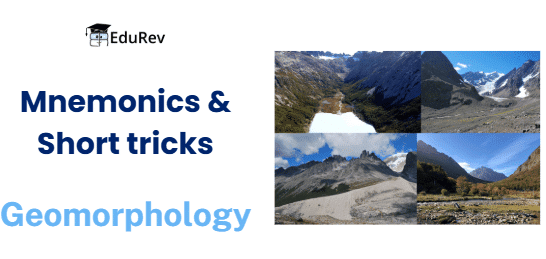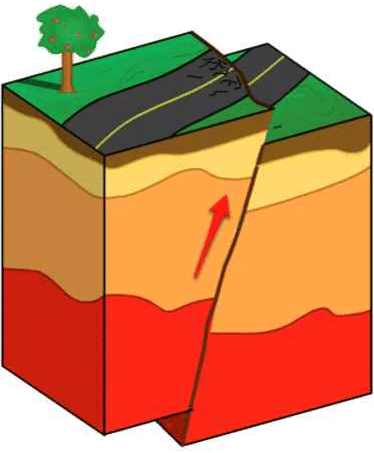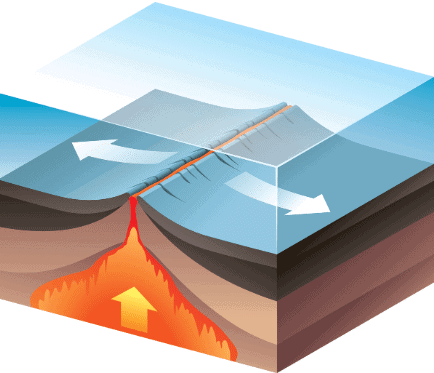Mnemonics : Geomorphology | Geography for UPSC CSE PDF Download
| Table of contents |

|
| 1. Types of Volcanoes |

|
| 2. Endogenic Forces |

|
| 3. Exogenetic forces |

|
| 4. Weathering |

|
| 5. Landslides |

|
This document will help you understand the key concepts of Geomorphology in a simple and engaging way. Inside, you'll find easy memory tricks (mnemonics) to help you recall important landforms, geological processes, plate tectonics, weathering, and erosion patterns.

Whether you're preparing for the UPSC, SSC CGL, or any other competitive exam, these mnemonics will make studying Geomorphology easier and more effective. Use them alongside your regular studies to grasp concepts quickly and retain information for a longer time!
1. Types of Volcanoes
Mnemonic: Some Cool Cats Find Magma
- S – Shield Volcanoes
- C – Composite Volcanoes
- C – Caldera
- F – Flood Basalt Provinces
- M – Mid-Ocean Ridge Volcanoes
2. Endogenic Forces
> Types of Endogenic Forces
Mnemonic: Discipline, Vision, Success.
- D – Diastrophism
- V – Volcanism
- S – Sudden Movements (Earthquakes, Tsunamis)
> Types of Diastrophism
Mnemonic: Old Elephants Dance Wildly

- O – Orogeny (Mountain building)
- E – Epeirogeny (Continental uplift/subsidence)
- D – Deformation (Folding, warping, fracturing)
- W – Warping (Bending of earth’s crust)
> Difference Between Orogeny and Epeirogeny
Mnemonic: Orogeny = Overlapping, Epeirogeny = Expansion
Orogeny : Forms mountains by overlapping rock layers through folding.
Epeirogeny : Causes continental expansion or subsidence without much folding.
> Causes of Endogenic Forces
Mnemonic : Real Tigers Hunt Prey
- R – Radioactivity (Heat from radioactive decay)
- T – Tidal friction (Movement of ocean tides)
- H – Heat flow (Primordial heat from Earth’s formation)
- P – Pressure changes (Internal pressure causing deformation)
3. Exogenetic forces
> Denudation (4 Phases)
Mnemonic: We Eat Thick Dal
- W – Weathering
- E – Erosion
- T – Transportation
- D – Deposition
4. Weathering
Types of Weathering
>Physical/Mechanical Weathering
Mnemonic: Four Elephants Gather Slowly
- F – Frost action
- E – Exfoliation
- G – Granular disintegration
- S – Salt weathering
>Chemical Weathering
Mnemonic: Cold Oranges Have Acidic Drops
- C – Carbonation
- O – Oxidation
- H – Hydrolysis
- A – Acid action
- D – Dissolution
> Biological Weathering
Mnemonic: Bats And Monkeys
- B – Bacteria
- A – Animals
- M – Microbes
5. Landslides
> Types of Landslides
Mnemonic: Five Tigers Love Small Snacks
- F – Falls
- T – Topples
- L – Lateral spreads
- S – Slides
- S – Slumps
6. Seafloor Spreading
>Steps of Seafloor Spreading: "H.O.M.E."

Mnemonic: H.O.M.E.
- H – Heat from mantle convection
- O – Ocean ridges form as magma rises
- M – Magma cools, creating new crust
- E – Expansion pushes older crust away
|
175 videos|619 docs|192 tests
|
FAQs on Mnemonics : Geomorphology - Geography for UPSC CSE
| 1. What are the different types of volcanoes and how do they differ from each other? |  |
| 2. What are endogenic forces and how do they shape the Earth's surface? |  |
| 3. What are exogenetic forces and their impact on the landscape? |  |
| 4. How does weathering occur and what are its types? |  |
| 5. What causes landslides and what are the different types? |  |















